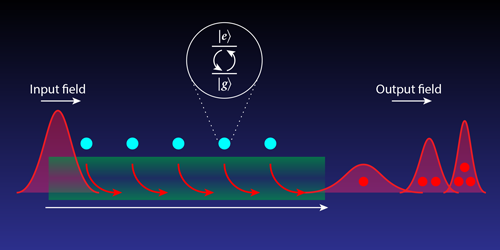Corralling Groups of Photons
The ability to generate groups of correlated photons could boost certain technologies, such as quantum metrology, where these groupings would greatly improve measuring accuracy. But creating photon “flocks” has long been a challenge. Now, Sahand Mahmoodian, of the Leibniz University Hannover in Germany, and colleagues propose a way to create these flocks that involves sorting a coherent pulse of light into bunches of strongly correlated photons.
The proposed device consists of an optical waveguide that is strongly coupled to a row of two-level quantum systems, for example atoms or qubits. A laser pulse is shone down the waveguide. Photons within the pulse are strongly connected to each other, such that the arrival of one portends the quick arrival of the next. The atoms absorb pulse photons, entering an excited state. If photons connected to the absorbed ones interact with the excited atoms, the connected photons stimulate emission by the atoms. Larger groups of partners lead to quicker stimulation and a reduced delay between absorption and emission by the atoms. As a result, the initial light pulse separates into size-dependent groups of connected photons, with the team finding that the number of coupled atoms determines the maximum photon-group size.
The team says that to make their proposal work, the atoms must only absorb photons coming in from one direction and only emit photons headed in the same direction, so that the flow of the photons through the waveguide is all in one direction. This direction-dependent coupling is already possible with state-of-the-art technologies, potentially allowing for quick implementation.
This research is published in Physical Review X.
–Christopher Crockett
Christopher Crockett is a freelance writer based in Arlington, Virginia.




